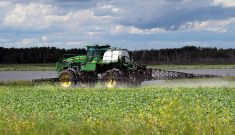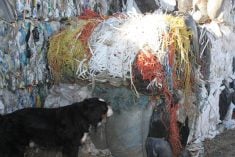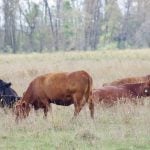More than 100 farmers from across the Prairies are in negotiations with the multinational company Monsanto, claiming the chemical called Sundance has harmed crops after it was supposedly rinsed from field sprayers.
The chemical is registered for use on wheat, but problems occurred once sprayers were rinsed out and used on other crops.
Carman Read, executive director of business stewardship with Monsanto in Red Deer, Alta., said most people had no problems but the company is trying to determine why some farmers and custom sprayer applicators apparently had difficulty getting the chemical rinsed from spray tanks.
Read Also

Canadian farmers need level playing field for regulations – says Minister MacDonald
Federal agriculture minister Heath MacDonald is urging the Canadian Food Inspection Agency and the Pest Management Regulatory Agency to speed up their decision making.
“This year, when people started using the product under different agitation and spraying conditions, there seemed to be some residual buildup in the tank,” said Read.
He wouldn’t say how many acres are affected, but said in some cases “significant acres” are involved.
The company is working with each farmer to reach an agreement on compensation, Read said.
Leduc, Alta., farmer Dave Wedman said he washed and bleached his sprayer with extra strength dairy bleach and rinsed the screens, but even after three tanks, there was still some chemical damage to 200 acres of canola.
“I’ve sprayed with all sorts of herbicides and never had a wreck before.”
Wedman wants compensation for the entire 200 acres. Monsanto has said it is willing to pay compensation for damage on 80 acres, the area sprayed with the first tank after Sundance.
“They kept telling us we’d be very happy … I don’t think I’m totally very happy.”
He is also disgruntled with the $5.50 per bushel compensation offered.
“I’m getting really tired of paying all these chemical costs and have something like this happen and they say this is all they can offer.”
Mitch Lokke, also of Leduc, had problems with chemical residue after his 80-acre canola field was sprayed by a custom applicator.
About 40 acres of canola is “absolutely smoked” and another 30 acres will yield about half what was expected, he said. At first, Lokke thought the crop was a writeoff, but now believes some of it will produce seed.
Monsanto has promised to work with each farmer but Lokke said he isn’t happy with the service or compensation. He wants at least $300 an acre for lost crop and inconvenience.
“If it’s under $300 an acre, I’ll be fit to be tied. I think that’s an absolute joke. They are a big company and this looks very bad on them,” said Lokke. “They should have paid us right away and got us to shut up.”
Wilson McQuay, manager of Agricore’s Agro Centre in Swan River, Man., is working with four farmers in his area who bought the chemical from his outlet.
“We sold the product, so therefore any problems between the farmers and chemical company, we will help smooth things out. We do this with all our products.”
Crops recover slightly
McQuay first heard about the problem when farmers reported it to him.
“At first it looked awful bad, like a plow-down situation. The crops are coming back but they’re definitely hurt.”
He said Monsanto is working with farmers in his region.
“I’m pleased to see how Monsanto is attempting to look after it.”
Read said the company is analyzing information on spraying and cleanout from each of the affected farms and is awaiting results from the Prairie Agricultural Machinery Institute in Humboldt, Sask., which it contracted to put the product through more rigorous testing.
The problem with residue was a surprise, said Read. Sundance had nine years of testing, including 143 in-field trials last year and this is the first time a residual problem
appeared, he said.














